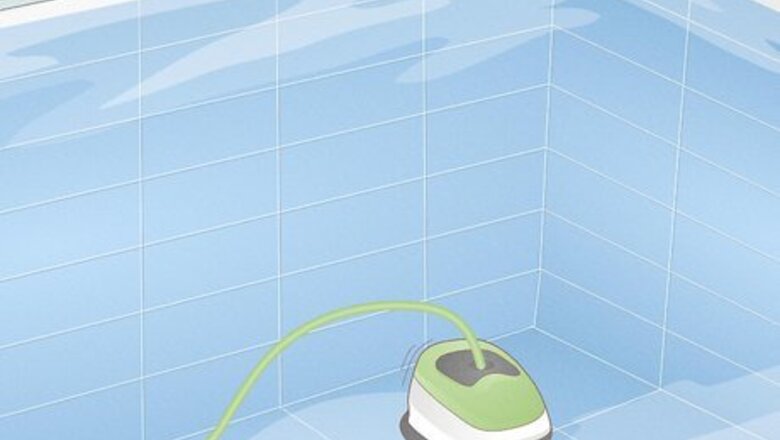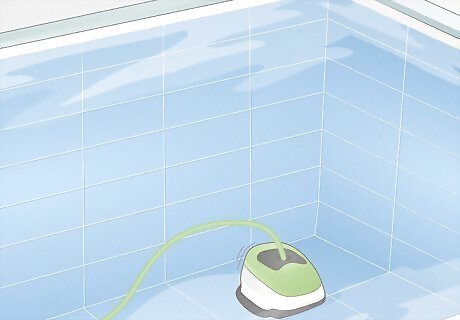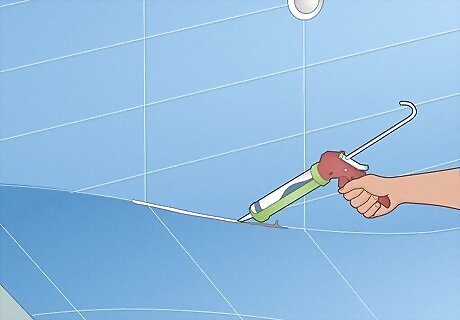
views
Applying the Chlorine
Drain your pool. Before you can chlorine wash your pool, you will need to drain it. Drain your pool using the waste line of your pool pump and motor system. Check your water discharge regulations before draining your pool so you can dispose of the water you pump out in a responsible manner. Many municipalities prohibit pumping water into street sewers. Instead, you’ll probably need to drain your pool into your sewer’s clean-out. Contact your local water and sewer department for information about how to drain your pool legally.
Coat the sides of the pool with liquid chlorine. Pour some liquid chlorine in a large watering can. Move around the inside of the pool with the watering can, pouring the water along the top edge of the pool so that the liquid chlorine washes down the sides. You should be able to see the algae visibly washing off the sides of your pool. It probably won’t be necessary to use undiluted liquid chlorine. Fill your watering can up about halfway with liquid chlorine and the rest of the way up with water. If you find the chlorine wash is not adequately removing the algae from your pool, decrease the amount of water you use in your watering can. You can get liquid chlorine at many big-box stores that deal in home and garden supplies.
Coat the bottom of the pool with chlorine. After applying the liquid chlorine to the sides of the pool, repeat on the bottom of the pool. Moving from one end of the pool to the other, pour the water/chlorine mix over the surface. Coat the entire bottom of the pool in the liquid chlorine mix.
Finishing the Chlorine Wash Process
Scrub away any remaining algae. If, after chlorine washing your pool, you see a few isolated spots of particularly tenacious algae, dip a stiff bristled brush in the liquid chlorine. Scrub the affected areas until the algae is gone. After chlorine washing your pool and scrubbing away any remaining algae, your pool should be algae-free. However, if scrubbing is not doing the trick, try a second chlorine wash using a water/chlorine mixture that contains less water and more liquid chlorine.
Rinse the pool down with water. Once you’ve pumped the chlorinated algae wastewater out of your pool, rinse the sides and bottom of the pool. This will wash off any algae that might have been loosened by the scrubbing process, and flush out algae that still lurks in cracks or crevices. Rinse the pool using a watering can filled with regular water. Pour the water over the pool’s surface just as you initially did when applying the chlorine wash to the pool. Alternately, break out a pressure washer to spray the sides and bottom of the pool off with a high-pressure spray.
Pump the liquid out of the pool. Once you’ve chlorine washed your pool, you’ll need to pump the dissolved algae and liquid chlorine out. Use your pool pump and motor system to remove the liquid just as you did when you initially drained it.
Preventing Algae Buildup
Maintain adequate chemical levels. When your pool is in use, you should test it two or three times weekly to ensure its chlorine, bromine, and alkalinity levels are within acceptable ranges. To test these levels, use a pool test strip. Just dip the strip into the water according to manufacturer directions and check the results. Typically, if the levels is off, the test strip will display a particular color. For instance, if the levels are normal, the test strip might show a blue color. If the levels are off, it might show a color like green or yellow. If any of your pool’s chemical levels are off, apply the appropriate product (chlorine, bromine, or another product) in amounts that enable you to get your pool within the acceptable level. The amount of each product you’ll need to maintain a chemically balanced pool depends on your pool’s size and the amount of chemical product already in your pool. Consult the product instructions and/or your pool’s owner manual to determine how much of each product you should use. You can obtain pool test strips from any big box store that deals in pool supplies or home and garden products.

Use an automatic cleaner. If you have an automatic cleaner, you can run it to prevent your pool from developing a buildup of algae. There are many makes and models of automatic pool cleaners, but generally, operating one is as easy as pressing the “on” switch and dropping it in your pool. Running the automatic cleaner once each week should be sufficient.
Keep your pool’s filter and pump clean. The pool pump and filter are like the lungs of the pool. If they are clean, the pool can “breathe” easily and will stay clean and healthy. If they are dirty, you might see algae. Cleaning the filter at least once a month is usually sufficient, though if you notice a lot of gunk in the filter, you might need to begin cleaning it more often. Consult your pool’s user guide for directions regarding how to clean the pool filter. Generally, you’ll need to turn the pump off and relieve the pressure in the filter. Remove the filter head off the filter and slip the pool filter out of the filtration unit. Spray the filter down using a high-pressure hose. Replace the cartridge and close the top of the filtration unit when you’re done.

Fill in cracks in your pool. Algae often takes root in the cracks the develop in the sides or bottom of the pool where circulation is poor. After emptying your pool, chlorine washing the sides, and scrubbing it clean, you’ll have the opportunity to fix any cracks that may have developed in the sides or bottom. You can easily fill in pool cracks using a specialized pool caulk or pool plaster (for instance, Pool Putty or a similar product).
Redirect your returns. If you have an in-ground pool, the pool’s filtration system will take water in, filter it, then spit it back into the pool. The returns are the aptly-named parts of the pool that return the water to the pool after filtration is complete. By aiming your returns down or to the side, you can prevent or eliminate recurring algae. The return redirection process will vary slightly depending on your pool’s design. In most cases, though, you can simply turn the directional eyeball (the structure that aims the water back into the pool) to the direction you want it. Most in-ground pools have two or three returns. Above-ground pools will not have a return system.



















Comments
0 comment